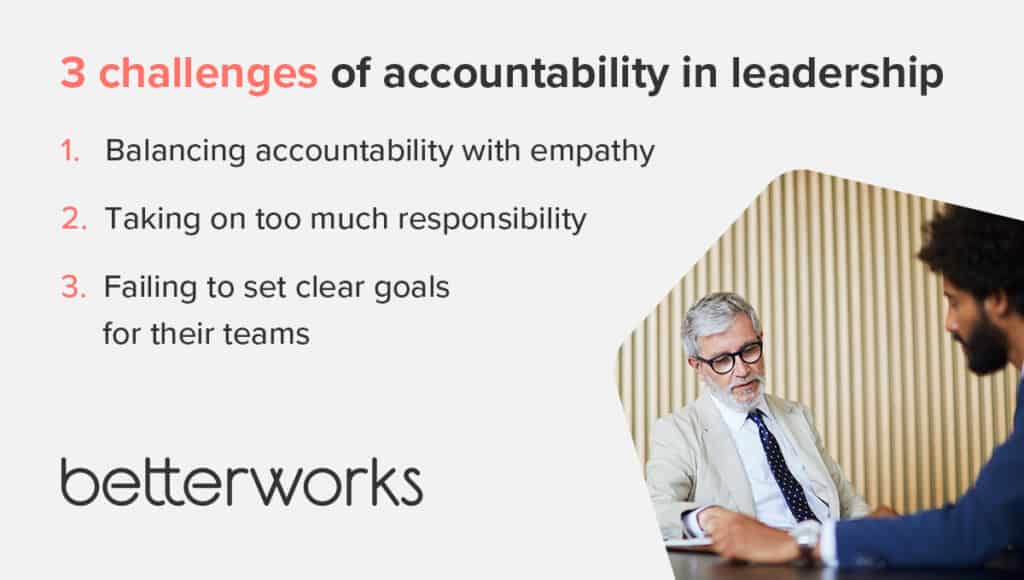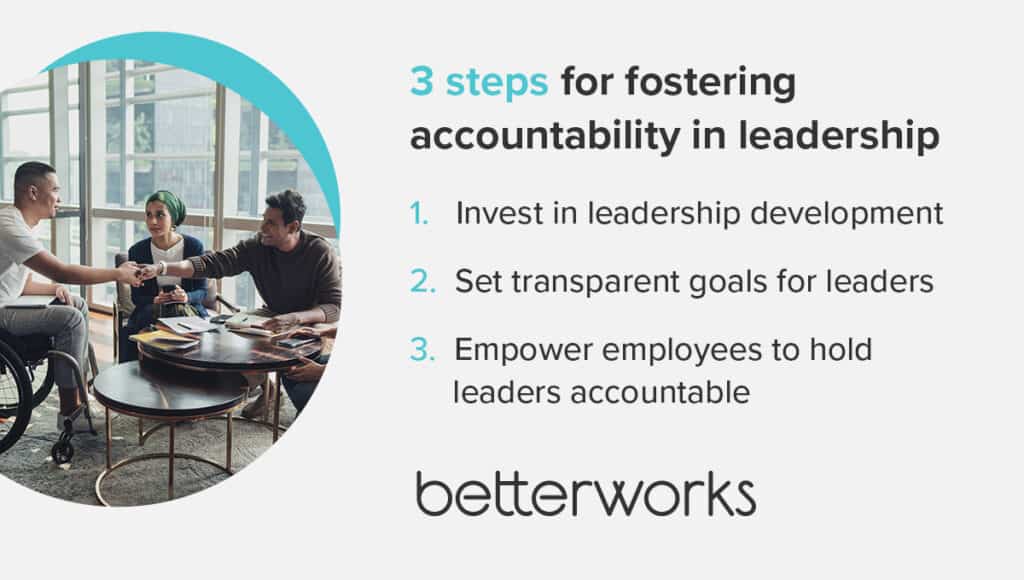- What does it mean to be accountable as a leader?
- Why is accountability in leadership important?
- 3 challenges of accountability in leadership
- 3 steps for fostering accountability in leadership
- How OKRs can promote leadership accountability
- 6 leadership accountability examples
- Support leadership accountability to lead your business to success
Leaders set the tone for the rest of the organization. By holding themselves accountable, they inspire everyone down the line to take responsibility for their actions and follow through on their commitments. Without leadership accountability, however, organizations tend to suffer from misalignment, lack of ownership, and a failure to execute strategic initiatives.
While leaders are ultimately responsible for accountability, your organizational structure and operations contribute. Many companies don’t have the cultural infrastructure in place to set clear expectations for leaders. As HR leaders, it’s your role to underscore accountability in the workplace — from the executive suite down to front-line employees.
Companies need strong leadership to close the loop between strategy, people, and results. Here’s how to foster leadership accountability at your company.
What does it mean to be accountable as a leader?
Leadership accountability in business is an overlooked but essential component of a healthy culture. But what is an accountable leader, and how do they drive business results?
“Accountability” suggests that leaders answer to someone or something. There are numerous ways to measure this. One is business performance. But leaders must also be accountable to company culture (stated mission, vision, values, and purpose) and to the workforce itself.
For leaders to be accountable, they need to commit to the business and its people. They must take their role as people leaders seriously and build trust among team members. Accountable leaders clearly communicate their goals to their teams to foster alignment and team focus. They accept responsibility when things go wrong and give credit where it’s due.
Accountable leaders are responsible for the people who report to them, too. Executive leadership, for instance, must hold middle managers accountable for their commitment to the business, company culture, and workforce.
HR plays a critical role in making sure that leaders hold themselves and their teams accountable for the right priorities. If “accountability” is too narrowly focused on achieving results at the expense of values or ethics, you could wind up with unethical behaviors that destroy value and create liability (such as what happened at Wells Fargo in the 2010s, when its sales culture placed employees under such pressure to reach ambitious goals that they responded by creating fake accounts).
By aligning company values with specific behavioral and performance expectations, HR leaders can help leaders understand what accountability looks like and how to live it within the organization. Leaders, in turn, foster team accountability by developing teams that think critically about the company’s needs and how they can contribute.
Owning mistakes is a key aspect of accountability, and it’s also the first step to learning from inevitable mistakes while continuing to move forward. A manager may fail to provide clear direction to an employee taking on a new task, for example, which results in poor performance. By acknowledging the mistake in not providing better guidance, that manager can improve such instruction going forward.
By aligning company values with specific behavioral and performance expectations, HR leaders can help leaders understand what accountability looks like and how to live it within the organization. Leaders, in turn, foster team accountability by developing teams that think critically about the company’s needs and how they can contribute.
Download now: Strong leadership starts with strong manager-employee relationships
Why is accountability in leadership important?
Leadership accountability helps organizations stay on track, even in tense or uncertain work climates. On the business side, this means keeping employees aligned with the strategy no matter what job role they have.
Lack of accountability is bad for business and for company culture, which affects workers’ morale and motivation. If team members see that leaders don’t respect the company’s values, the risk of unethical behavior skyrockets.
If leaders are leaders in name only, employees are more likely to feel disconnected from their work and colleagues. Team members may feel bitter about leaders collecting larger paychecks, for example, if they aren’t leading by example.
By contrast, strong workplace cultures can reap the benefits of accountability. For instance, organizations with high leadership accountability tend to be healthier, according to McKinsey’s State of Organizations 2023 report. That research found that leadership accountability was one of eight key factors driving positive work-related outcomes.
Accountability contributes to high-performing teams and a culture of excellence. When everyone is aligned on priorities and company values, leaders have an easier time getting buy-in and providing targeted and constructive feedback.
3 challenges of accountability in leadership
Developing accountable leaders isn’t without its challenges. Keep these three concerns in mind when building a culture of accountability.
Balancing accountability with empathy
Some leaders view accountability and empathy as mutually exclusive — they fear that if they show empathy, sympathy, or compassion to people, they’ll be less effective in holding them accountable. Other leaders lean too far the other way, avoiding holding people accountable because they’re concerned about the personal relationship or how the team member will react.
According to a study by the Society for Human Resource Management, however, the most effective leaders are those who figure out how to embrace accountability and empathy and foster a working environment of high performance and trust.
Taking on too much responsibility
Another challenge to fostering a culture of accountability is leaning too heavily into responsibility. With this mindset, leaders take on too much responsibility, including performing tasks that should be delegated. The negative consequences include micromanaging, burnout, and failing to develop their team members’ confidence and abilities.
Failing to set clear goals for their teams
Leaders in organizations often find themselves struggling to maintain accountability among their teams. One cause of this is a lack of clear team and individual goals. Employees don’t know what they’re responsible for and become frustrated when they’re then judged on a confusing, shifting set of goals.
This clarity starts at the top. When the organization’s strategy, values, and goals are clear, it’s easier for leaders to work with their teams on meaningful individual goals.
Accountability contributes to high-performing teams and a culture of excellence. When everyone is aligned on priorities and company values, leaders have an easier time getting buy-in and providing targeted and constructive feedback.

3 steps for fostering accountability in leadership
While most people have an innate sense of accountability, HR leaders can develop processes and programs to encourage the workforce to actively hold themselves and each other accountable. Check out these three steps for cultivating better leaders by building accountability into business programs.
Invest in leadership development
Add a layer of accountability with leadership development programs, including mentoring. Middle managers should have an executive mentor to help them envision their career path and stay on track. Leaders at the top should have an executive coach or other mentor to support their continued personal growth.
Set transparent goals for leaders
When leaders have transparent goals, their teams can see what they’re working toward. This fuels accountability because the signs of success are clear, and there are no excuses. This encourages leaders to exercise personal accountability and ask for help when they need it. Communicating openly about goals also fosters team camaraderie and aligns everyone on shared objectives.
Empower employees to hold leaders accountable
Create a system of checks and balances to ensure leaders are held accountable for their actions and that employees can raise concerns when leaders aren’t acting appropriately.
Provide anonymous channels employees can use to provide feedback to leaders at all levels. At a team level, encourage open dialogue between team members and their managers. Leaders may have blindspots in their behaviors that transparent feedback can help to uncover.

How OKRs can promote leadership accountability
You need a defined framework to hold people accountable for their work. Objectives and key results (OKRs) provide a structure for setting organizational and individual goals. That structure supports accountability for leaders and their reports.
OKR programs force leaders to be intentional about goal-setting for themselves and their team members. They’ll need to embrace transparency and open conversations around goal-setting, measurement, and assessment. OKR governance has three components: accountability, alignment, and focus. Here’s how to use each of these elements to promote leadership accountability.
Accountability
OKRs depend on two-way communication to foster accountability. Executives must set the business strategy and priorities, but employees should be empowered to set their own goals, as long as they align with overall objectives. This dual structure empowers leaders and employees to discuss their goals and explore how they align. Leaders need to take accountability for this alignment.
Goal-setting is just the first stage of accountability. Ongoing check-in conversations are opportunities to assess progress and make adjustments. At the end of each quarter, leaders should walk their teams through what worked and what didn’t and pinpoint why. These discussions require everyone to take responsibility, speak candidly about events, and address shortcomings.
Alignment
Accountable leaders drive vertical alignment of individuals’ goals to overall business objectives. But horizontal alignment is crucial, too. Horizontal alignment refers to alignment across departments or teams.
As you set OKRs, be sure to document dependencies. The goal-setting process is the time to clarify who’s responsible for each component of an objective. This is especially true for goals that are shared across departments or teams and might not work together often. Appoint a clear owner to foster accountability, support communication, and encourage transparency during this process.
Focus
OKRs won’t come to fruition without sufficient focus and commitment. First, companies must bring their objectives into focus so leaders can communicate them to their teams. Second, workers must commit to their individual objectives. Part of that process involves creating specific, focused, and measurable key results for each objective.
Individuals need to feel accountable for their own OKRs, and leaders have to set the tone. Consider creating an OKR template to keep employee objectives on track. The template should lay out OKR ownership so that individual employees know their objectives for the quarter. Goal alignment software can create another layer of accountability by placing individual OKRs in the larger context.
6 leadership accountability examples
Leadership accountability is like a muscle: Exercising it makes it stronger. Help leaders see the countless opportunities to practice this in the flow of work. Here are six examples of everyday situations where leaders can exercise accountability.
Setting goals
Accountable leaders set goals that align with the business’ priorities. This gives them personal accountability for driving business results. They foster that same sense of ownership in their direct reports.
When leaders go first in creating clear, aligned, and transparent goals, they make accountability much easier to embrace throughout the team. One such example is Betterworks customer Grupo Posadas, which created focus and accountability around its strategic imperatives by starting with its executives.
Driving performance
Accountable leaders help their reports set clear performance objectives that align with the business, their strengths, and their interests. After the goal-setting process, these leaders provide constructive and continuous performance feedback through regular conversations. They help identify problem areas and work with team members to investigate their causes. By supporting their people, these leaders build closer relationships based on trust and accountability.
Team building
In team meetings, leaders and team members walk the line of holding people accountable without playing blame games or focusing only on the negative.
Through team-building activities, employees can learn to be accountable for their roles, move beyond obstacles, and collaborate on solutions. By building trust and understanding, team members can work together to create a strong team dynamic that encourages accountability and leads to better outcomes.
Fostering trust
Leaders who hold themselves and others accountable for their actions show that they are willing to take responsibility for mistakes, not just successes. This demonstrates a commitment to the team and the organization and serves as a reminder that everyone is accountable for their actions and decisions.
Living with integrity
Leaders undermine their integrity when they fail to take personal accountability. People with integrity live their principles honestly and without compromise. Integrity is a direct result of living in accordance with their values and being accountable for their actions.
Employees will recognize integrity when they see it — and they’ll definitely notice when it’s absent. If leaders aren’t accountable to company values, employees will perceive their behavior to be dishonest. Leaders with integrity, on the other hand, set a good example and inspire their employees to live their values, too.
Facilitating transparency
Accountable leaders are transparent with their employees. They share their goals, progress, and how they’re trying to get better. They don’t avoid hard conversations, and they keep employees in the loop on anything that affects their work. Team members, in turn, are more likely to open up about their work, the challenges they’re facing, and any questions or feedback they may have.
Support leadership accountability to lead your business to success
Leadership accountability is a prerequisite for an organizational culture that’s goals-focused, transparent, and supportive. Start by setting clear top-level goals and being transparent about how the company — and everyone in it — is expected to contribute. Augment those high-level goals with OKRs that cement your workforce’s accountability, alignment, and focus. When expectations are clear, and the workforce is aligned on its priorities, your company can accurately assess results and hold everyone accountable.
Learn more about how leaders demonstrate accountability.
How to Stregthen Manager-Employee Relationships







